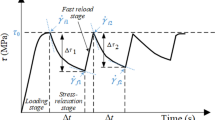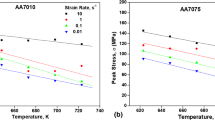Abstract
The abnormal behavior of monotonic stress-strain curves of aluminum alloys induced by the yield drop with increasing strain rate or decreasing temperature is considered based on the relaxation model of plasticity. The plastic deformation of 2519A and 2519A-T87 aluminum alloys within the strain rate range from 0.001 to 6000 s–1 and temperature range from –45 to 450°С is analyzed from the standpoint of determining the structural and temporal characteristics of the material invariant to the strain rate. It is proposed to determine the change in the structural and temporal characteristics caused by the test temperature choice by analyzing a set of strain rate dependences of the material constructed at a fixed temperature. The temperature dependences of the characteristic relaxation time as a rate sensitivity factor of the relaxation plasticity model are compared for 2519A and 2519A-T87 aluminum alloys. Theoretical nonmonotonic stress-strain curves in a wide strain rate range of 0.001–6000 s–1 are constructed at –45, 0, 20, 150°С, and nonmonotonic stress-strain curves at a fixed strain rate of 4300 s–1 are plotted at temperatures of 150, 300, 450°С. The relaxation model of plasticity is shown to predict the yield stress within a wide range of temperatures and strain rates in accordance with the temperature-time superposition principle. The model also identifies the temperature-strain rate conditions of deformation in which monotonic curves (without the yield drop) are not observed with increasing strain rate.







Similar content being viewed by others
REFERENCES
Johnston, W.G., Yield Points and Delay Times in Single Crystals, J. Appl. Phys., 1962, vol. 33, no. 9, pp. 2716–2730.
Sancho, R., Cendon, D., and Galvez, F., Mechanical Behaviour of Al2024-T3 Sheet Metal at Different Strain-Rates and Temperatures, Proc. Eng., 2017, vol. 197, pp. 158–167.
Rajaraman, S., Jonnalagadda, K.N., and Ghosh, P., Indentation and Dynamic Compression Experiments on Microcrystalline and Nanocrystalline Nickel, in Conference Proceedings of the Society for Experimental Mechanics Series, 2013, vol. 1, pp. 157–163.
Selyutina, N.S. and Petrov, Yu.V., Comparative Analysis of Dynamic Plasticity Models, Rev. Adv. Mater. Sci., 2018, vol. 57, pp. 199–211.
Uenishi, A. and Teodosiu, C., Constitutive Modelling of the High Strain Rate Behaviour of Interstitial-Free Steel, Int. J. Plasticity, 2004, vol. 20, no. 4–5, pp. 915–936.
Larour, P., Rusinek, A., Klepaczko, J.R., and Bleck, W., Effects of Strain Rate and Identification of Material Constants for Three Automotive Steels, Steel Res. Int., 2007, vol. 78, no. 4, pp. 348–358.
Mocko, W. and Kruszka, L., Results of Strain Rate and Temperature on Mechanical Properties of Selected Structural Steels, Proc. Eng., 2013, vol. 57, pp. 789–797.
Johnston, W.G. and Gilman, J.J., Dislocation Velocities, Dislocation Densities, and Plastic Flow in Lithium Fluoride Crystals, J. Appl. Phys., 1959, vol. 30, pp. 129–144.
Liu, W., He, Z., Tang, C., and Chen, Y., Effect of Deformation Condition on Dynamic Mechanical Properties and Microstructure Evolution of 2519A Aluminum Alloy, J. Mater. Eng., 2016, vol. 44, no. 1, pp. 47–53.
Ye, L., Dong, Y., Zhang, Y., Sun, D., and Zhang, X., Effect of Test Temperature and Strain Rate on Dynamic Mechanical Behavior of Aluminum Alloy 2519A, J. Mater. Eng. Performance, 2019, vol. 28, pp. 4964–4971.
Zhang, X., Li, H., Li, H., Gao, H., Gao, Z., Liu, Y., and Liu, B., Dynamic Property Evaluation of Aluminum Alloy 2519A by Split Hopkinson Pressure Bar, Trans. Nonferrous Met. Soc. China, 2008, vol. 18, pp. 1–5.
Zerilli, F.J. and Armstrong, R.W., Dislocation-Mechanics-Based Constitutive Relations for Material Dynamics Calculations, J. Appl. Phys., 1987, vol. 61, no. 5, pp. 1816–1825.
Liu, W., He, Z., Chen, Y., and Tang, S., Dynamic Mechanical Properties and Constitutive Equations of 2519A Aluminum Alloy, Trans. Nonferrous Met. Soc. China, 2014, vol. 24, pp. 2179–2186.
Rusinek, A. and Klepaczko, J.R., Shear Testing of a Sheet Steel at Wide Range of Strain Rates and a Constitutive Relation with Strain-Rate and Temperature Dependence of the Flow Stress, Int. J. Plasticity, 2001, vol. 17, no. 1, pp. 87–115.
Couque, H., Boulanger, R., and Bornet, F., A Modified Johnson–Cook Model for Strain Rates Ranging from 10–3 to 105 s–1, J. Phys. IV, 2006, vol. 134, pp. 87–93.
Kang, W.J., Cho, S.S., Huh, H., and Chung, D.T., Modified Johnson–Cook Model for Vehicle Body Crashworthiness Simulation, Int. J. Vehicle Design, 1999, vol. 21, no. 4–5, spec. iss., pp. 424–435.
Khan, A.S., Suh, Y.S., and Kazmi, R., Quasi-Static and Dynamic Loading Responses and Constitutive Modeling of Titanium Alloys, Int. J. Plasticity, 2004, vol. 20, no. 12, pp. 2233–2248.
Selyutina, N., Borodin, E.N., Petrov, Y., and Mayer, A.E., The Definition of Characteristic Times of Plastic Relaxation by Dislocation Slip and Grain Boundary Sliding in Copper and Nickel, Int. J. Plasticity, 2016, vol. 82, pp. 97–111.
Selyutina, N.S. and Petrov, Yu.V., Effect of Plastic Strain Stabilization under Low-Cycle Deformation, Phys. Mesomech., 2020, vol. 23, no. 5, pp. 384–389.
Cadoni, E., Dotta, M., Forni, D., and Kaufmann, H., Tensile Behaviour of Commercial Aluminium Alloys Used in Armor Applications at High Strain Rates, Proc. Eng., 2017, vol. 197, pp. 168–175.
Petrov, Y.V. and Utkin, A.A., Dependence of the Dynamic Strength on Loading Rate, Sov. Mater. Sci., 1989, vol. 25, no. 2, pp. 153–156.
Gruzdkov, A.A. and Petrov, Yu.V., On Temperature–Time Correspondence in High-Rate Deformation of Metals, Dokl. Phys., 1999, vol. 44, pp. 114–116.
Johnson, G.R. and Cook, W.H., Fracture Characteristics of Three Metals Subjected to Various Strains, Strain Rates, Temperatures and Pressures, Eng. Fract. Mech., 1985, vol. 21, no. 1, pp. 31–48.
Funding
The work was performed at the support of the Russian Science Foundation (Project 19-71-00093).
Author information
Authors and Affiliations
Corresponding author
Additional information
Russian Text © The Author(s), 2019, published in Fizicheskaya Mezomekhanika, 2020, Vol. 23, No. 1, pp. 33–40.
Rights and permissions
About this article
Cite this article
Selyutina, N.S. Prediction of the Temperature-Time Effects of Irreversible Deformation for 2519A Aluminum Alloy. Phys Mesomech 23, 487–493 (2020). https://doi.org/10.1134/S1029959920060041
Received:
Revised:
Accepted:
Published:
Issue Date:
DOI: https://doi.org/10.1134/S1029959920060041




